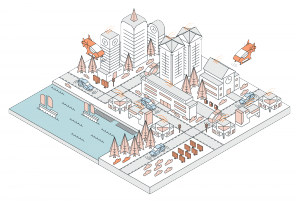
6 Future Trends for Empathic AI in the 2020s
Empathic tech company Sensum predicts 6 key trends of the coming decade, for technology that can measure and respond to people's feelings
BELFAST, COUNTY ANTRIM, UNITED KINGDOM, December 19, 2019 /EINPresswire.com/ -- After nearly a decade of measuring human states in the wild, empathic tech company Sensum provides six key trends to expect in the coming decade.1) Empathic Tech will Move from Projects to Products
2) Adoption Will Start at the Edges and Move Inwards
3) The Technology will Disappear
4) Empathic AI will be Infused in the Connected World
5) Empathic AI Ethics Will Move into the Public Conversation
6) There will be Increased Sophistication in Understanding Human States
Interest is rapidly growing in technology that can measure and respond to emotions and other human states. This ‘empathic AI’ has the potential to enhance all kinds of human-machine interaction but also brings several ethical questions with it. Sensum, which has been providing empathic tech solutions to major global customers since 2011, predicts that there will be widespread adoption of empathic AI in consumer products and services globally over the next ten years.
Sensum’s analysis of the future development of empathic technology is summarised in six key trends:
1) Empathic Tech will Move from Projects to Products
The next few years are likely to bring on the widespread adoption of empathic AI into consumer technology. Until now, innovation in this space has sat mainly in the realm of experimental projects. There has been plenty of enthusiasm for the technology but little understanding of realistic business models and use-cases.
Now we are seeing many organisations taking empathic tech seriously, testing various outcomes in order to design optimal product & service implementations. In the first half of the coming decade we can expect to find cars, phones, computers and many other ubiquitous products imbued with varying levels of empathic measurement and interaction capabilities.
2) Adoption Will Start at the Edges and Move Inwards
Right now for instance, many smartphones can detect their users’ faces and offer a range of silly selfie filters that are tracked to the users’ facial features. But consider that Apple bought the facial-coding startup Emotient back in 2016, so the same software that tracks your facial movement could feed emotional measurement algorithms in your mobile. Are Apple and others waiting for the ‘killer app’ that could introduce empathic AI gently and enjoyably, without freaking out their customers? Soon we expect to see many examples of soft, toe-dipping exercises, as brands cautiously roll out empathic features.
From the other end of the spectrum, look at perhaps the primary impetus for the growing interest in empathic tech in the automotive space: driver monitoring for safety. With the Euro NCAP Road Map 2025 endorsing the implementation of driver monitoring systems in vehicles this coming year, the automakers are seeking advanced monitoring capabilities to save lives. We predict that the human-state modelling features in vehicles will spread incrementally from life-saving safety functions over to comfort and experiences.
3) The Technology will Disappear
We have seen increasing demand, and concurrent innovation, in ever less intrusive sensors for collecting human data. Heart rate, as a key example, can be measured accurately via a sensor strapped to the chest. Failing that, you might use a wrist-worn sensor. But now there is a growing set of contactless solutions such as ultra wide-band and millimetre-band biometric radar, or biometric imaging techniques such as infrared and transdermal optical imaging. These increasingly accurate and inexpensive technologies, combined with clever product design and ergonomics, will continue to reduce the ‘footprint’ that the sensors impress on the user, eg. by being embedded invisibly in your seat or keyboard.
4) Empathic AI will be Infused in the Connected World
While organisations are currently developing empathic technologies largely in isolation from each other, there are obvious advantages to connecting with other services in an integrated digital ecosystem. As people move from, say, their car to their office and back to their house, they could be carrying a persistent digital profile that allows each device or interaction to perform better due to the rich information that is generated by the user’s ongoing activities.
5) Empathic AI Ethics Will Move into the Public Conversation
As these new sensing capabilities have been growing, there has been a parallel increase in public discourse, and backlash, against some of the technologies’ effects, both real and potential. For example, there has been a surge in news stories about facial recognition systems in the last year, urging caution about their misuse. And although facial recognition is very different to face-based emotion measurement, the two could understandably be conflated in the public mindset. In any case, similar levels of concern might be starting to arise for wider empathic processing methods, including facial coding, voice analysis, physiological signals and beyond.
The potential problems that this technology could trigger need to be discussed, and both governments and organisations alike have a responsibility to act preemptively to protect people. However, it would be a great loss to society if smart technology, boosted by empathic processing, was derailed by misguided assumptions or unethical actors.
6) There will be Increased Sophistication in Understanding Human States
While there are very reasonable concerns about the potential misuse of technology that can measure emotions and other human states, there is also widespread oversimplification and misunderstanding about what those states are, and how effective such technologies are capable of being. Take for instance the recent critique of facial coding and the six ‘basic emotions’, which attempts to unpick long-standing notions and clarify where the science of emotion is going.
Our industry, along with government, academic institutions and others, have a responsibility to educate our stakeholders and the public to help them make more sophisticated judgements about this kind of technology. Psychology is a relatively young science, and the fields of emotions and affective computing are still quite green. We must manage expectations if we are to avoid a well-deserved backlash.
Ben Bland
Sensum
+44 28 9066 0629
email us here
EIN Presswire does not exercise editorial control over third-party content provided, uploaded, published, or distributed by users of EIN Presswire. We are a distributor, not a publisher, of 3rd party content. Such content may contain the views, opinions, statements, offers, and other material of the respective users, suppliers, participants, or authors.



